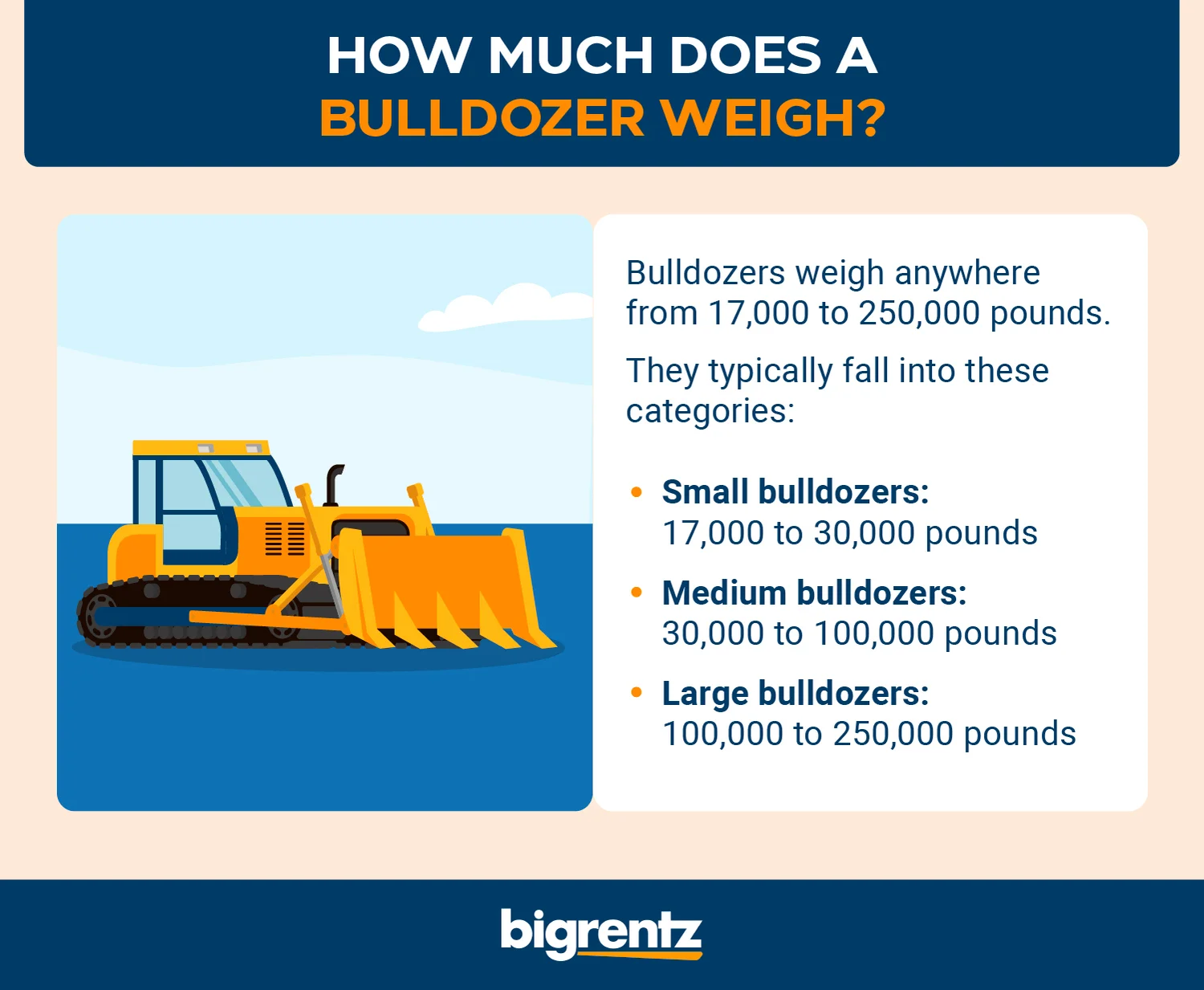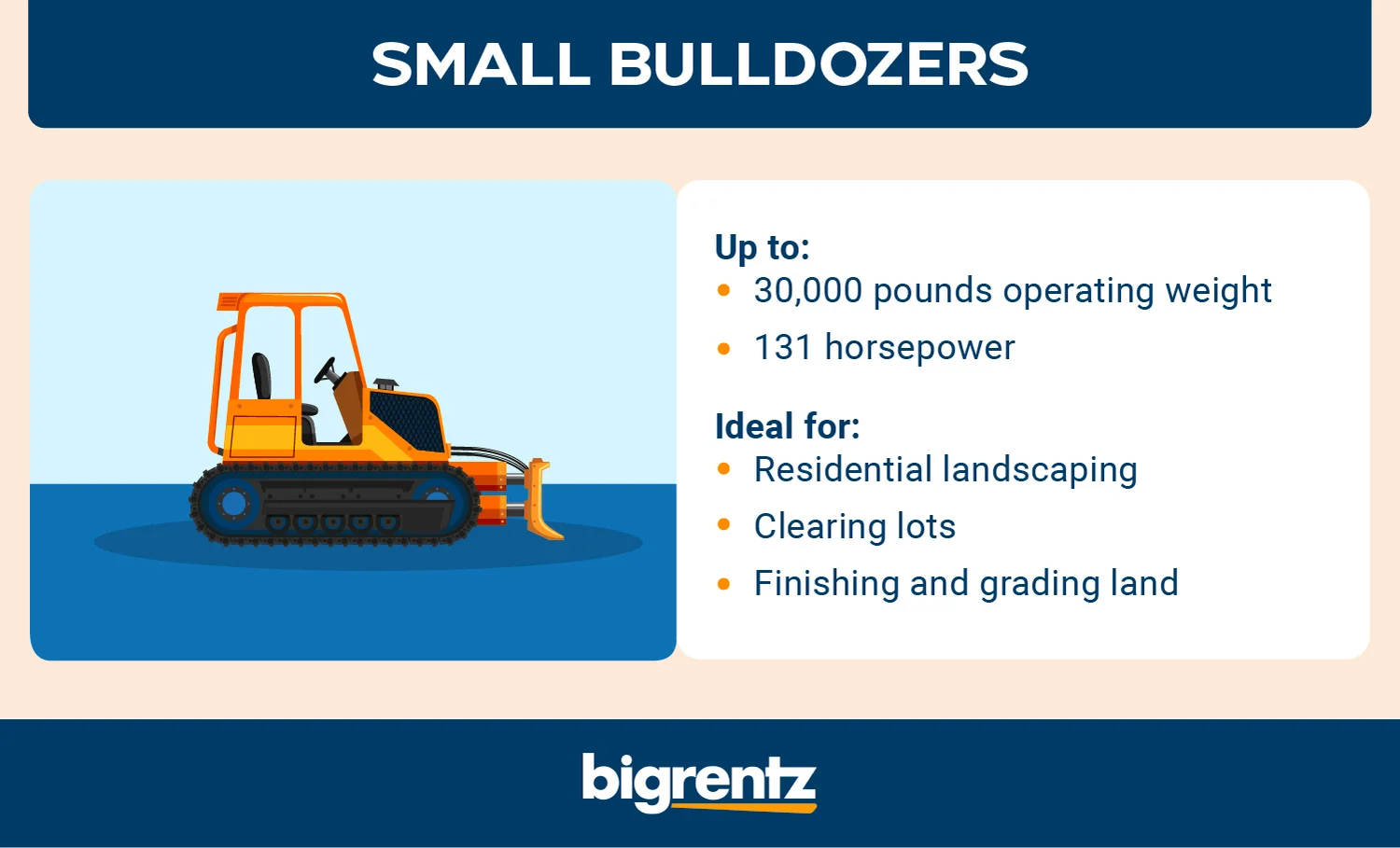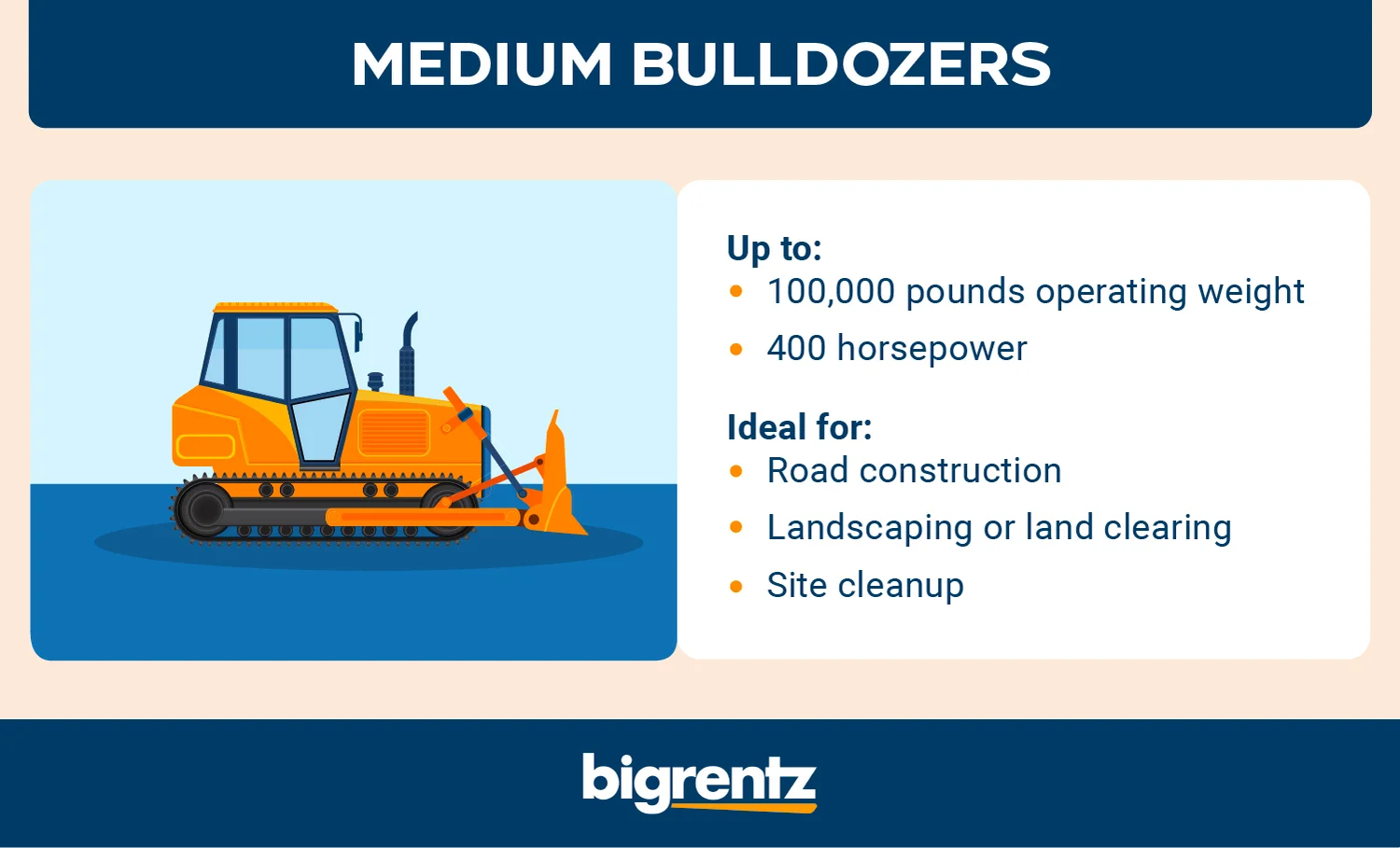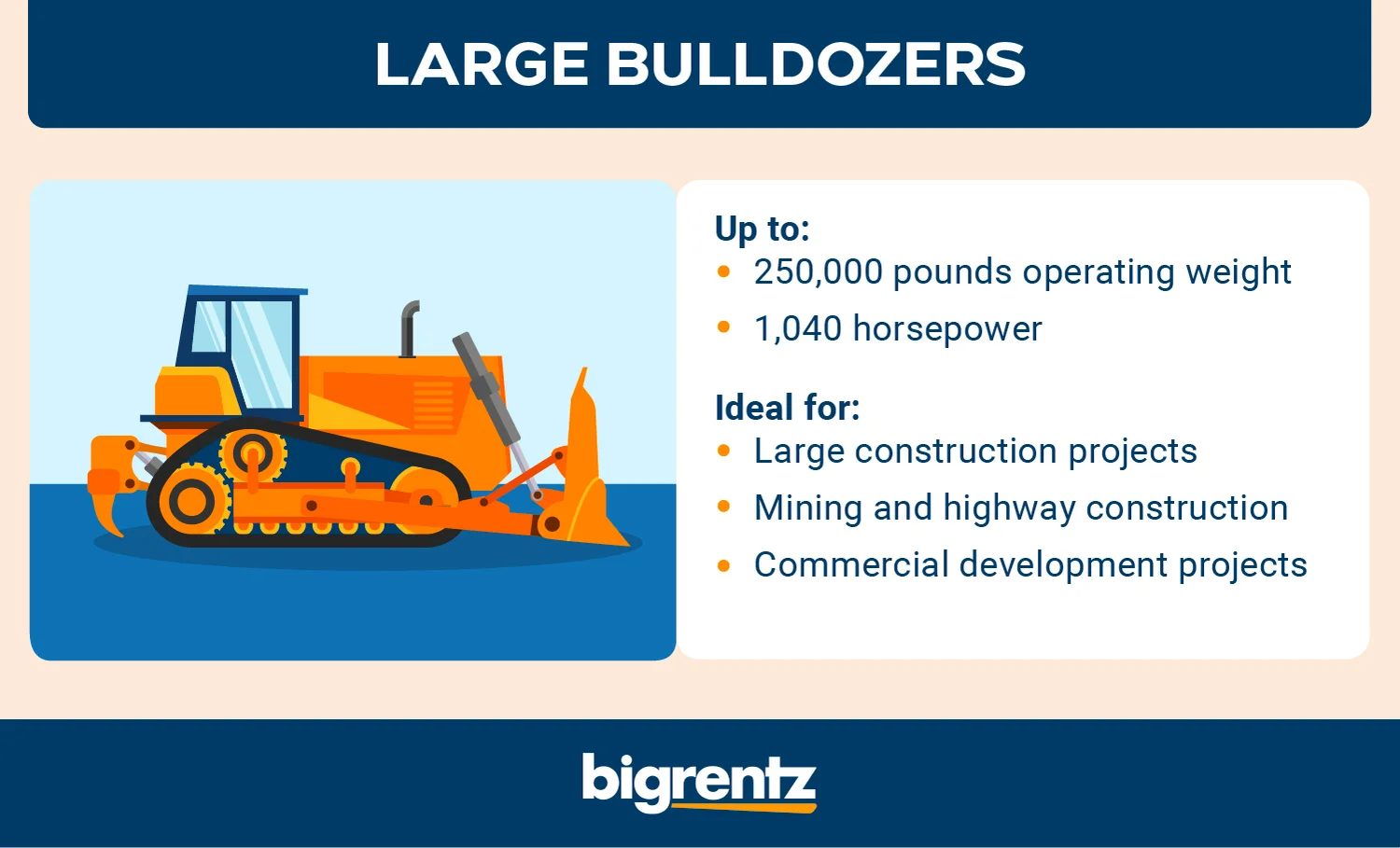Bulldozers commonly weigh anywhere from 17,000 to 250,000 pounds. On the extreme high end, the ACCO Super Bulldozer holds the world record for the largest dozer, weighing in at 366,000 pounds, but it wasn’t used due to a trade embargo.
These machines are categorized into small, medium, and large based on their operating weight. Their capabilities also correspond to their size, ranging from residential landscaping to typical construction sites, all the way to heavy duty mining projects.
Explore All Bulldozers
While size and weight classifications vary slightly by brand, the general ranges are as follows: small bulldozers are typically less than 30,000 pounds, medium bulldozers are typically between 30,000 to 100,000 pounds, and large bulldozers are between 100,000 to 250,000 pounds.

Common Bulldozer Sizes
The bulldozers you’ll find on the market typically fall into three weight classes: small, medium, and large. Here’s an overview of each class, including the typical weights and capabilities of the vehicles in them.
Small (Up to 30,000 pounds)

A small bulldozer is a compact machine known for maneuverability and versatility. It is meant to handle projects on small job sites or in residential areas.
The typical operating weight for this size classification is up to 30,000 pounds, with power capabilities of up to 131 horsepower. This makes small dozers ideal for residential landscaping, clearing lots, finishing and grading land, and other small construction projects. The small, compact size means they’re safe to use in areas with soft or easily damaged terrain.
When it comes to blades, small bulldozers typically use straight blades, or S-blades, since straight-edged blades are the most suitable for these project types.
Medium (Between 30,000 and 100,000 pounds)

Medium dozers are also known for their versatility since they work well for small-to-large project types. They’re great for projects like road construction applications, large-scale landscaping, site cleanup, and other industrial-type projects.
Their mid-range weight and power capabilities mean they’re not too large for small applications, while also big enough to work on larger spaces and handle heavy loads.
The typical operating weight for the medium bulldozer size classification is between 30,000 and 100,000 pounds, with power capabilities typically up to 400 horsepower. These machines work well on all types of roads, parks or golf courses, and even power plants, completing tasks like building foundations or roads, landscaping or land clearing, forestry, and site cleanup.
Semi U-blades, a combination of universal blades and straight blades, are typical for medium dozers. These blades are less curved than universal blades, but they’re still able to push decent amounts of soil.
Large (Between 100,000 and 250,000 pounds)

Large bulldozers are the largest size option, built for moving great volumes of earth. A large bulldozer can be as large as 250,000 pounds, perfect for large construction projects, quarries and mining, and highway construction.
These big bulldozers range from about 100,000 to 250,000 pounds. Their size and power capabilities, up to about 1,000 horsepower, make vehicles in this size classification perfect for heavy-duty jobs like airport infrastructure projects, highway construction, and large commercial development projects like shopping malls.
Since they’re the largest blade type, universal blades are the best choice for large dozers, equipping these machines to push large amounts of soft to medium-density soil across long distances.
Attachments Impact a Bulldozer’s Operating Weight
A dozer’s operating weight includes its attachment. There are a wide range of bulldozer attachments that cater to different construction and earth-moving tasks. Here’s an overview of some of the most common dozer attachment options and example weights. Remember, attachment weights will vary by size and application.
Angle Blade
An angle blade on a bulldozer is used for pushing, leveling, and moving granular materials. It typically has curved wings that allow for better material control and maneuverability.
- Angle tilt blade weight: 4,250 pounds (12’ by 2’3”)
Straight Blade
An S-blade is used for simple pushing and grading tasks, providing a straight and flat surface. It doesn’t have wings—it’s a single solid blade with a straight edge—so it can’t handle pushing granular materials as well as other blades.
- Straight blade weight: 4,090 pounds (John Deere 750 C WT)
Universal Blade
U-blades are used for long pushes with larger side wings than the semi-u blade, curving to keep materials pushing along. They are good for a variety of tasks like leveling, pushing, and grading materials.
- Universal blade weight: 4,500 pounds (12’ by 4’3”)
Semi-universal Blade
An SU-blade is used for various grading and shaping tasks. Its slightly curved or tapered wings give it versatility and advanced cutting ability, helping in material control and maneuverability.
- Semi universal blade weight: 3,350 pounds (11’7” by 4’7”)
Other Attachments
Bulldozers also support specialized attachments like rakes and rippers. Rakes can help clear brush while rippers are used for breaking up hard ground, rocks, or pavement.
- Stacking rake weight: 3,215 pounds (11’ by 7’5”)
- Blade rake weight: 7,930 pounds (11’5” by 5’7”)
- Ripper weight: 12,620 pounds (2’9” dig depth)
How to Choose the Right Size Bulldozer
Choosing the right size and bulldozer model comes down to what your specific needs are. If you need a bulldozer for a light residential job, you’ll probably want something on the smaller end. If it’s for a large-scale industrial job, you’ll want a heavy-duty vehicle.
Here are some key considerations to keep in mind when you’re shopping around:
- Project size and scope: Your project size and scope might be the most important factor in your choice of dozer. As mentioned above, small projects, like residential landscaping jobs, do better with smaller, lightweight dozers. But large projects that require heavy or major earthmoving, like mining, require bigger dozers.
- Power: The heavier duty your job is, the more power you’ll need. Typically, bigger dozers come with more power and capability. The engine power of your machine should be enough to get the job done.
- Track or wheels: Choosing tracks or wheels, or track dozers or wheel dozers, comes down to the type of terrain you’re working on. Tracks are best for soft, muddy, ground, since they can distribute the vehicle’s weight, reducing ground pressure. Wheels are better for harder ground.
- Attachment capabilities: Dozers come with different attachment capabilities, so make sure the vehicle you choose is compatible with the blade capacity and attachments you need. Some attachments may have power requirements that can’t be fulfilled by smaller machines.
How Much Does a Bulldozer Rental Cost?
If you need to rent a bulldozer, the cost depends on your location, the machine size, and your rental period, day, week, or month. BigRentz has machines of all sizes available for whatever time frames you need. Here are the average rental costs:
- 70–79 hp bulldozer: $468/day, $1,154/week, $3,549/month
- 80–89 hp bulldozer: $538/day, $1,494/week, $3,989/month
- 90–99 hp bulldozer: $537/day, $1,549/week, $4,520/month
Explore All Bulldozers
Ready to Rent a Bulldozer?
If you’re looking for a bulldozer to rent, you’ve come to the right place. Whether you need a machine for a quick residential job or a large-scale construction site, we’ve got you covered. From large vehicles to small, BigRentz has dozers of all sizes to meet your equipment rental needs.
